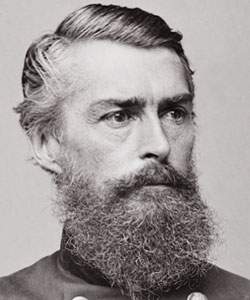Herman Haupt, Railroads (American National Biography)
Scholarship
In 1840 Haupt helped construct the York and Wrightsville Railroad in Pennsylvania. In so doing he discovered that no American railway engineer had previously assessed the strength of railway trusses in bridge construction. He therefore completed some technical experiments, and he was later recognized as having devised a means of "representing strains of geometrical solids; deflections by parabolic areas; and the variable pressures at various parts of beams by the corresponding ordinates of plane curves" (Lord, p. 24). He continued with this work and in 1841 published an anonymous booklet, Hints on Bridge Construction. Ten years later a revised and expanded version, The General Theory of Bridge Construction, appeared under his authorship. This pioneering study became a respected text in the field.
Keir B. Sterling, "Haupt, Herman," American National Biography Online, February 2000, http://www.anb.org/articles/13/13-00718.html.
Herman Haupt, Civil War (American National Biography)
Scholarship
In April 1862…[Secretary of War] Edwin M. Stanton, [Simon] Cameron's successor, asked Haupt to come to Washington. Stanton recognized that civilian railroad men were better prepared to construct and maintain railroads than the military engineers, who had more experience with field fortifications and coastal defenses….For nearly seventeen months, until September 1863, Haupt designed, built, and repaired critically important railway lines and bridges. President Abraham Lincoln inspected one bridge project Haupt had completed and characterized it as "the most remarkable structure that human eyes ever rested upon. That man Haupt has built a bridge across Potomac Creek, about 400 feet long and nearly 100 feet high, over which loaded trains are running every hour, and upon my word . . . there is nothing in it but bean poles and corn stalks" (Lord, p. 77). Haupt had to cope with conflicting lines of authority, appealing to the War Department when more senior officers attempted to take over his lines for the movement of their own troops and equipment. At no time, despite Haupt's strong urging, was any one individual given overall authority over military railroads. Historians have generally agreed that he coped brilliantly with most logistical challenges, moving troops to the front, wounded to the rear, and equipment to where it was most needed with efficiency and dispatch. Haupt's unflagging efforts to assist in Major General John Pope's withdrawal from the battle of Second Bull Run (Second Manassas) in August and September 1862 won him a promotion to brigadier general of volunteers.
Keir B. Sterling, "Haupt, Herman," American National Biography Online, February 2000, http://www.anb.org/articles/13/13-00718.html.



